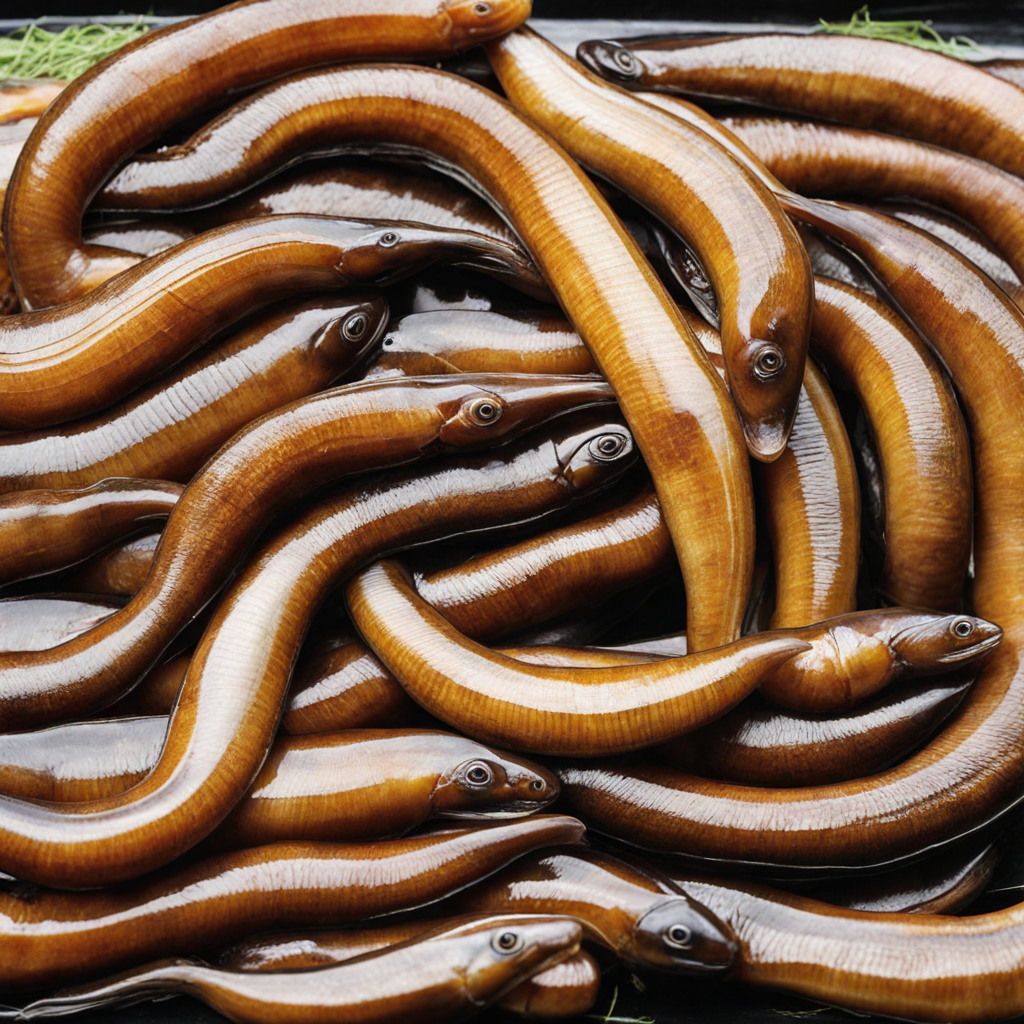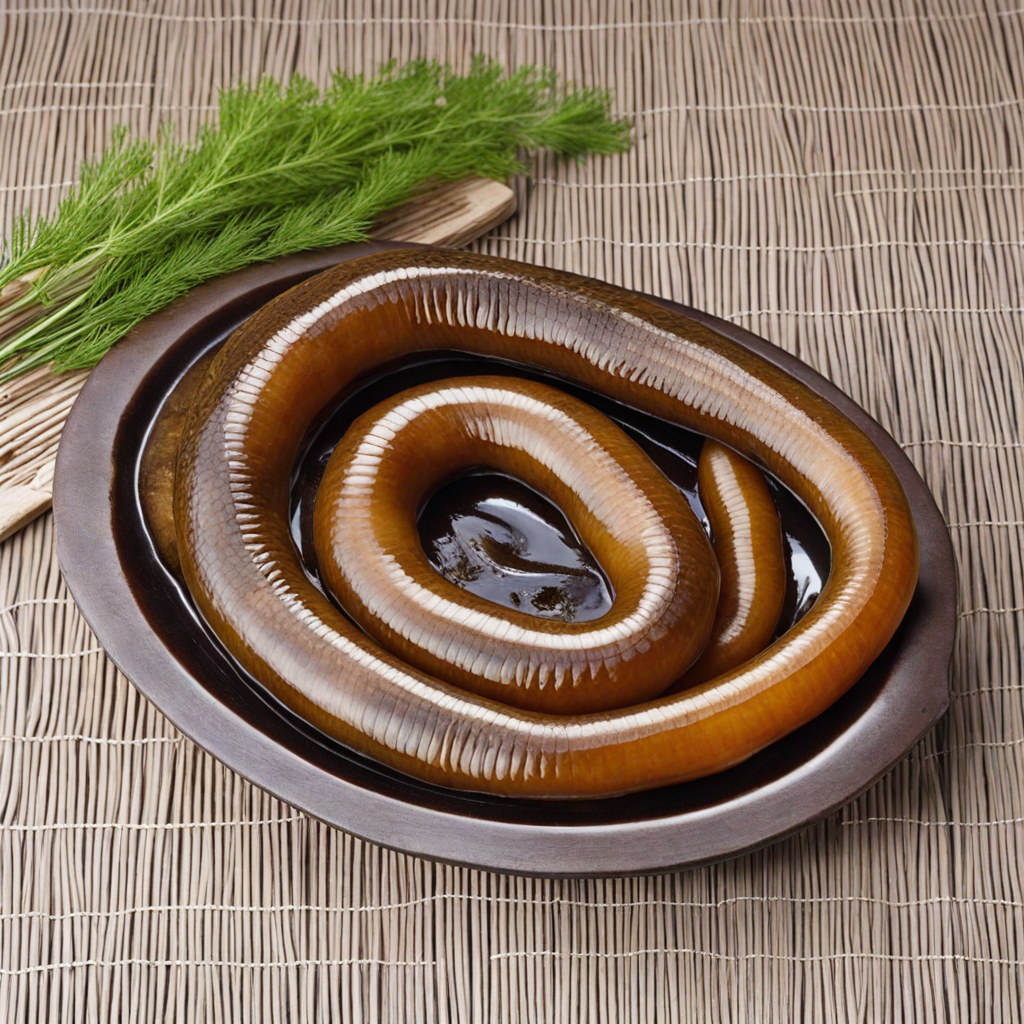Smoked Lamprey
Smoked lamprey is a unique delicacy hailing from the coastal waters of Estonia, where it has been a cherished part of the culinary tradition for centuries. This eel-like fish, known for its elongated body and distinctive appearance, is carefully prepared through a traditional smoking process that enhances its natural flavors. The smoking not only preserves the fish but also imparts a rich, smoky aroma that tantalizes the senses and invites exploration. Each bite reveals a combination of tender flesh and a slightly chewy texture, making it a fascinating experience for those willing to venture beyond conventional seafood. The flavor profile of smoked lamprey is complex and intriguing, characterized by a subtle sweetness that balances the savory smokiness. The fish absorbs the essence of the wood used during the smoking process, often resulting in hints of cedar or birch that linger on the palate. This unique taste is further complemented by the lamprey’s natural brininess, reminiscent of the sea, providing a refreshing contrast that keeps the dish interesting. It's a versatile ingredient, often enjoyed on its own or paired with crusty bread, pickles, and local cheeses, allowing for a delightful medley of flavors and textures on the plate. For those adventurous enough to try smoked lamprey, it’s not just a meal; it’s an experience that connects you to Estonia's rich maritime heritage. Traditionally served during festive occasions, this dish is a testament to the country's fishing culture and the artisanal skills of local smokehouses. Whether you enjoy it as part of a hearty platter or as a gourmet appetizer, smoked lamprey promises to expand your culinary horizons and introduce you to the distinctive tastes of Estonia, leaving you craving more of its unforgettable essence.
How It Became This Dish
The History of Suitsunäär: Estonia’s Smoky Delicacy #### Origins Suitsunäär, a traditional Estonian dish, consists mainly of smoked eel, and its roots can be traced back to the coastal regions of Estonia, particularly in areas where fishing has been a vital part of the local economy and culture. The term "suitsunäär" translates to "smoked eel" in English, highlighting its primary ingredient and method of preparation. The practice of smoking fish dates back centuries in many cultures, but in Estonia, it reflects a unique blend of indigenous culinary practices and the influences of neighboring countries. Historically, the Baltic Sea has been a significant source of sustenance for Estonian communities. The abundant eel population, particularly in the brackish waters of the Estonian coastline, made it a staple in the diet of the coastal inhabitants. Fishing methods were often communal, with families and neighbors working together to catch and prepare their catches. The process of smoking eel, which involves curing the fish with salt and then exposing it to wood smoke, developed as a means of preservation, allowing the fish to be stored for extended periods. #### Cultural Significance Suitsunäär is more than just a dish; it is a representation of Estonian identity and tradition. The act of preparing and consuming smoked eel is often associated with communal gatherings and celebrations. In rural Estonia, smoking fish was a practice that brought families together, often taking place during festivals, harvests, and special occasions. The preparation of suitsunäär is steeped in ritual; it often signifies a connection to the land and the sea, underscoring the importance of nature in Estonian life. In addition to its culinary importance, suitsunäär also holds a place in Estonian folklore and cultural narratives. Eels are often featured in local legends and stories, symbolizing resilience and adaptability. The dish has also been a part of Estonian culinary heritage showcased during national festivals, food exhibitions, and cultural events, where it serves as a reminder of the country’s rich maritime history and reliance on local resources. #### Development Over Time The evolution of suitsunäär reflects broader changes in Estonian society, particularly during the 20th century. The interwar period (1918-1940) was a time of national awakening for Estonia, during which traditional foods began to be celebrated as symbols of national identity. Suitsunäär was embraced not only as a delicious food item but also as a point of pride among Estonians, reinforcing the idea of a unique cultural heritage. The Soviet occupation from 1940 to 1991 brought significant challenges to traditional Estonian food practices. The emphasis on collective farming and state-controlled food production led to changes in dietary habits and food availability. Many traditional recipes, including those for suitsunäär, faced the risk of being lost. However, the resilience of Estonian culture shone through, as home cooks and local fishers continued to prepare and enjoy smoked eel, often in secret or in small communities. Following Estonia's independence in 1991, there was a revival of interest in traditional foods, and suitsunäär experienced a renaissance. The late 20th and early 21st centuries saw a renewed appreciation for Estonian cuisine, with chefs and home cooks alike seeking to preserve and promote traditional recipes. Suitsunäär began to appear on restaurant menus, not just as a nostalgic dish but as a gourmet offering that showcased local ingredients and artisanal smoking techniques. As Estonia embraced its European identity, suitsunäär was increasingly recognized in the broader culinary scene. It became an integral part of Estonia's participation in international food festivals and culinary competitions, representing the country's rich maritime heritage. The dish also found its way into modern interpretations, with chefs experimenting with flavors, presentations, and pairings, while still honoring the traditional preparation methods. #### Modern-Day Suitsunäär Today, suitsunäär is celebrated both in Estonia and abroad, often served as an appetizer or part of a traditional meal. It is typically accompanied by dark rye bread, which complements the smoky flavor of the eel, and may be garnished with pickles, onions, or freshly grated horseradish. The dish has found fans among food enthusiasts who appreciate its unique flavor and the craftsmanship involved in its preparation. Estonian chefs are also experimenting with suitsunäär by incorporating it into various modern dishes. For instance, it may be used in salads, pasta, or as a filling for pastries, showcasing the versatility of this traditional ingredient. Additionally, with the rise of sustainable fishing practices and a growing emphasis on local sourcing, the preparation of suitsunäär is increasingly focused on ecological responsibility, ensuring that the eel population remains healthy for future generations. The popularity of suitsunäär extends beyond dining; it has become a culinary ambassador for Estonia, introducing international diners to the country's rich food culture. In recent years, food tourism has flourished in Estonia, with many visitors seeking authentic experiences that include traditional dishes like suitsunäär. Local food markets, festivals, and culinary workshops have become platforms for sharing the story of this beloved dish. #### Conclusion Suitsunäär embodies the essence of Estonian culinary heritage, reflecting the country's deep connection to its coastal environment, communal traditions, and evolving identity. From its humble beginnings as a means of preserving fish to its status as a gourmet delicacy, suitsunäär tells the story of the Estonian people—a story of resilience, cultural pride, and a celebration of local flavors. As Estonia continues to navigate its place in the global culinary landscape, suitsunäär will undoubtedly remain a cherished symbol of its rich gastronomic history.
You may like
Discover local flavors from Estonia







